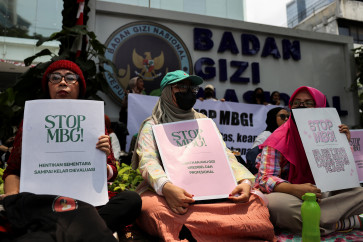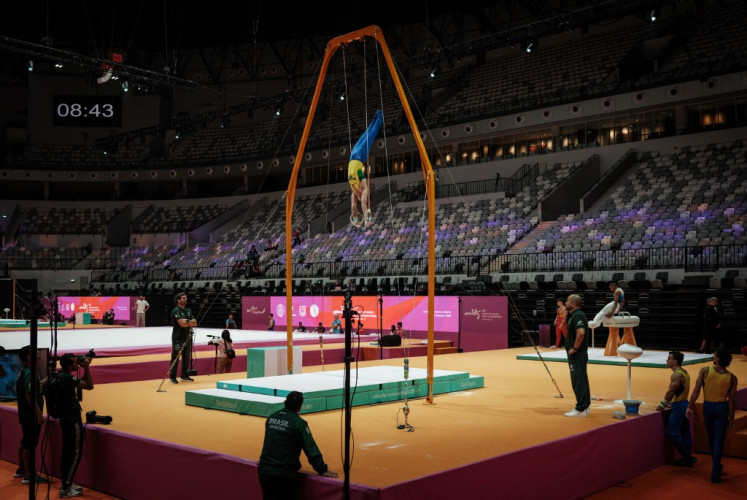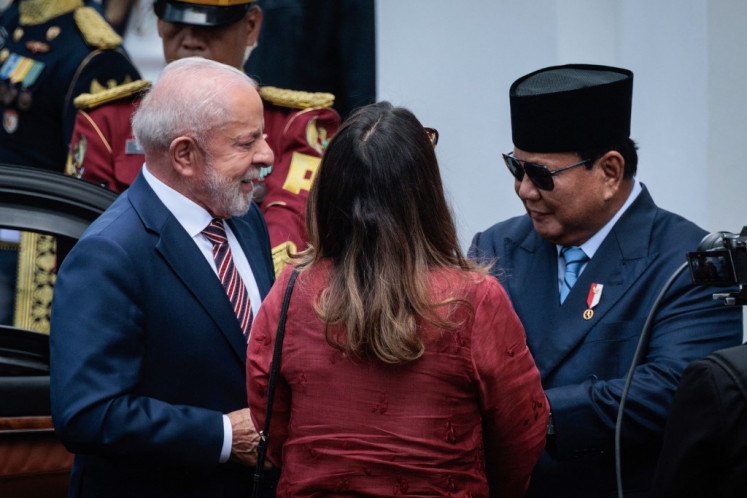Popular Reads
Top Results
Can't find what you're looking for?
View all search resultsPopular Reads
Top Results
Can't find what you're looking for?
View all search resultsWearing sarong part of daily life and showcases identity
Madura’s legacy: A spectator wearing santri fashion, a sarong and koko (male Muslim attire), watches a cow-plow contest, which is typical of the culture of Madura, in Probolinggo, East Java
Change text size
Gift Premium Articles
to Anyone
M
adura’s legacy: A spectator wearing santri fashion, a sarong and koko (male Muslim attire), watches a cow-plow contest, which is typical of the culture of Madura, in Probolinggo, East Java. (JP/Aman Rochman)
Shaped like a large tube made of fabric, the sarong meets the particular needs of worship, sleep and relaxation, among other things, making it a familiar fashionable item among many Indonesians.
Aceng, a 50-year-old farmer from Cianjur, West Java, said that sarong is part of his daily outfit, which he loves very much, because it is easy to wear and practical.
“I wear a sarong not only when I perform the shalat prayer in a mosque or mushola (prayer room) but also when I do other activities,” he said.
“I roll up my sarong when I work in my paddy field to prevent it from exposure to the mud,” he adds.
At night, like many other villagers, he uses the sarong as a blanket when sleeping, he says.
For Tanto Priambodo, an employee of a private company, his daily habit of wearing a sarong started in his childhood. “Although I now live in Jakarta, I wear a sarong almost every day when I am relaxing at home,” he said.
Like other Muslims, he also wears a sarong for worship in a mosque or mushola.
“A sarong is simpler to wear, it allows me to move freely and feel comfortable,” he said, adding, “Wearing a sarong helps boost blood circulation compared to when wearing a tight trouser.”
Acknowledging his penchant for the sarong thanks to its multifunctional uses and flexibility, Basuki wears it but not as frequently as he did several decades ago when he lived in a village in Klaten, Central Java.
Wearing a sarong is also part of his daily life. For him, the sarong also means a nostalgic, joyful and memorable experience.
“I wore sarong when I went out to join my rural companions to go on foot to another village to see a wayang (shadow puppet) performance. The sarong functioned as a jacket, which in those days was still rare, to protect me from the cold night air,” the 66-year-old retired man recollected.
“Watching the wayang performance when wearing a sarong was a wonderful experience that I could not forget. With the sarong, I could sleep in a curled position close to a somewhat hidden space where a gong player played,” he recollected in a happy tone.
Another unforgettable and funny experience related to the sarong was when he went out to join siskamling (community patrols) in the village after midnight. “All of a sudden, one of the siskamling members screamed ‘kuntilanak!’ (a female ghost with long hair) while pointing his finger at a tree. Running fearfully, my sarong loosened from my waist and I dropped it somewhere,” he said, giggling.
He said that since he moved to Jakarta, he wears the sarong only when he performs the prayer.
Identity
Aceng, Tanto and Basuki are among the many Indonesians whose daily life is inseparable from the sarong thanks largely to its advantages when it comes to its functions.
For particular ethnic communities and ethnic groups in Indonesia, the sarong wearing tradition was handed down from one generation to another and serves as an ‘identity’ that they are proud of. It is more than just a daily outfit.
Nahdiyin and Santri communities, for example, maintain their penchant for wearing the sarong because they want to showcase an Islamic identity.
Wearing a sarong is inherent in the culture of Nahdiyin, members of Nahdlatul Ulama (NU), the country’s largest Muslim organization. It is no little wonder that Nahdiyin, whose members are mostly clerics, are popularly known as “Kaum Sarungan” or a community that wears sarong on a regular basis.
In the language of NU members, the sarong is more practical because it is easy to wear; democratic in nature because it allows all bodily organs inside it to move freely, gelis or quick because it is quick to wear before doing something and isis or cool because it is loose.
For Indonesian Muslims, especially the santri community that pursues education in Islamic boarding schools, wearing a sarong is their identity as a Muslim community. The sarong serves as a symbol of pursuing education in the pesantren (Islamic boarding school).
In the Dutch colonial era, the sarong worn by santri is identical with the struggle to fight against Western culture represented by the trouser-wearing culture brought by the colonizers.
Some ethnic groups, especially the Tengger and Madura, also regard wearing sarong as having special meaning to their existence.
The sight of young and old men and women wearing sarong is common in Argosari Village, Tengger. Situated at a height of 2,000 meters above sea level, the village is cold at night and in the morning.
Wearing a sarong is how they protect against the cold air but “the sarong also is our self-esteem, trend and identity,” says Budiyanto, a spokesman for local tourism-awareness group as quoted by Kompas.com
In Tengger, a woman wearing a sarong in a particular way will show her real status, whether she is still single, married or a widow.
The Madura ethnic group also wears the sarong to show their identity.
The sarong has been introduced to locals since their childhood when they started to learn mengaji (reciting Quranic verses). Commonly, the sarong is used during several religious occasions such as tahlilan (prayer for the dead), shalat, Maulid Nabi (commemoration of the birthday of the Prophet Muhammad), ziarah (grave visits), etc.
The people of Madura wear a sarong for daily activities, starting from shopping in a market, worshipping in a mosque, working on their land, going to a bus terminal and at home. Men wearing a sarong while riding a bike or a motorcycle is a common sight in Madura.
“The sarong is also worn to attend official occasions,” says Tanto Priambodo, who once lived in Sampang Regency, Madura, to engage in a clean water development project for a couple of years.
A man who visits a family by an invitation is considered more polite when wearing sarong than wearing trousers. “He is considered to give more respect to those who invited him,” he says.










